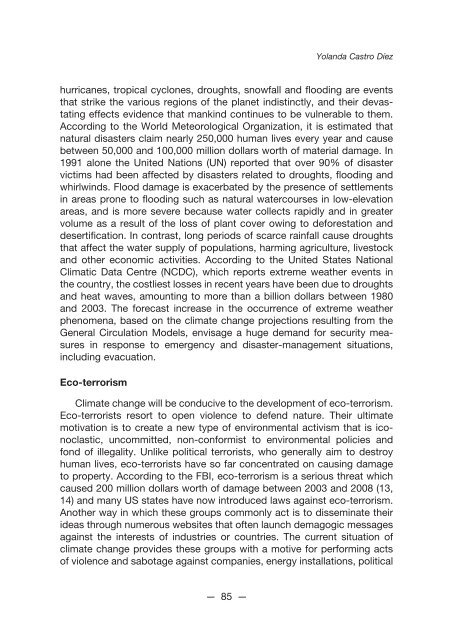Strategic Panorama 2009 - 2010 - IEEE
Strategic Panorama 2009 - 2010 - IEEE
Strategic Panorama 2009 - 2010 - IEEE
You also want an ePaper? Increase the reach of your titles
YUMPU automatically turns print PDFs into web optimized ePapers that Google loves.
Yolanda Castro Díez<br />
hurricanes, tropical cyclones, droughts, snowfall and flooding are events<br />
that strike the various regions of the planet indistinctly, and their devastating<br />
effects evidence that mankind continues to be vulnerable to them.<br />
According to the World Meteorological Organization, it is estimated that<br />
natural disasters claim nearly 250,000 human lives every year and cause<br />
between 50,000 and 100,000 million dollars worth of material damage. In<br />
1991 alone the United Nations (UN) reported that over 90% of disaster<br />
victims had been affected by disasters related to droughts, flooding and<br />
whirlwinds. Flood damage is exacerbated by the presence of settlements<br />
in areas prone to flooding such as natural watercourses in low-elevation<br />
areas, and is more severe because water collects rapidly and in greater<br />
volume as a result of the loss of plant cover owing to deforestation and<br />
desertification. In contrast, long periods of scarce rainfall cause droughts<br />
that affect the water supply of populations, harming agriculture, livestock<br />
and other economic activities. According to the United States National<br />
Climatic Data Centre (NCDC), which reports extreme weather events in<br />
the country, the costliest losses in recent years have been due to droughts<br />
and heat waves, amounting to more than a billion dollars between 1980<br />
and 2003. The forecast increase in the occurrence of extreme weather<br />
phenomena, based on the climate change projections resulting from the<br />
General Circulation Models, envisage a huge demand for security measures<br />
in response to emergency and disaster-management situations,<br />
including evacuation.<br />
Eco-terrorism<br />
Climate change will be conducive to the development of eco-terrorism.<br />
Eco-terrorists resort to open violence to defend nature. Their ultimate<br />
motivation is to create a new type of environmental activism that is iconoclastic,<br />
uncommitted, non-conformist to environmental policies and<br />
fond of illegality. Unlike political terrorists, who generally aim to destroy<br />
human lives, eco-terrorists have so far concentrated on causing damage<br />
to property. According to the FBI, eco-terrorism is a serious threat which<br />
caused 200 million dollars worth of damage between 2003 and 2008 (13,<br />
14) and many US states have now introduced laws against eco-terrorism.<br />
Another way in which these groups commonly act is to disseminate their<br />
ideas through numerous websites that often launch demagogic messages<br />
against the interests of industries or countries. The current situation of<br />
climate change provides these groups with a motive for performing acts<br />
of violence and sabotage against companies, energy installations, political<br />
— 85 —

















